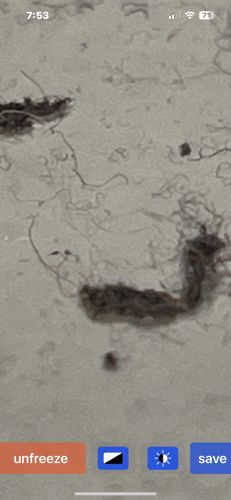Nematode (Roundworm)
Scientific Name: Nematoda (Phylum)
Order & Family: Phylum Nematoda (no specific order/family can be determined from the image alone)
Size: Most free-living nematodes are microscopic, typically 0.3 mm to 2 mm in length, though some can be larger. Parasitic forms vary widely, from a few millimeters to several meters (e.g., some whale parasites).

Natural Habitat
Nematodes are ubiquitous, found in almost every habitat from polar regions to tropical hot springs. They are abundant in soil (both terrestrial and aquatic), freshwater, marine environments, and as parasites of plants and animals.
Diet & Feeding
Diet varies greatly depending on the species. Free-living nematodes can be bacterivores (feeding on bacteria), fungivores (feeding on fungi), predators (feeding on other nematodes or small invertebrates), or omnivores. Parasitic nematodes feed on the tissues, fluids, or ingested food of their hosts.
Behavior Patterns
Nematodes move using a characteristic undulating motion. Most species are free-living, but parasitic forms have complex life cycles involving hosts. They can enter a dormant state (cryptobiosis) to survive harsh conditions.
Risks & Benefits
Risks: Many species are parasitic, causing significant diseases in plants (e.g., root-knot nematodes causing crop damage), animals (e.g., heartworm in dogs), and humans (e.g., Ascaris, hookworms, filarial worms causing various illnesses). Benefits: Free-living nematodes are crucial decomposers in soil ecosystems, contributing to nutrient cycling and soil health. Some are used as biological control agents against insect pests.
Identified on: 8/28/2025